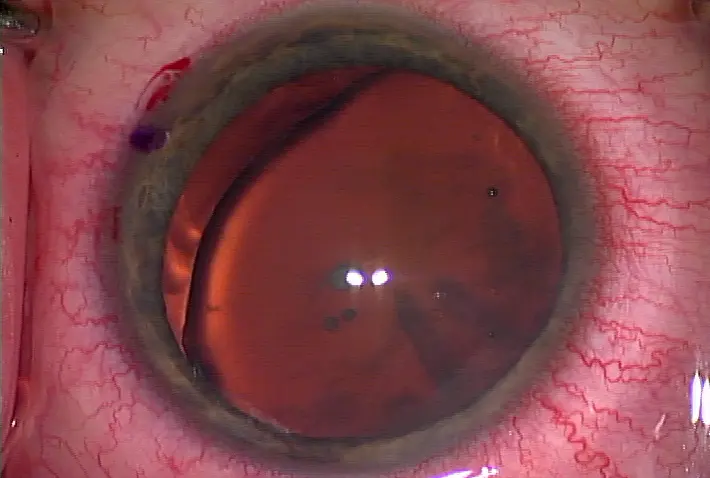Recent studies recommend toric IOLs for astigmatism patients
Recent studies recommend toric IOLs for astigmatism patients
EyeWorld.April 2011
Two recent studies recommend the use of toric IOLs, such as the AcrySof Toric IOL (Alcon, Fort Worth, Texas), to correct astigmatism
Source: Alcon
Source: Alcon
While peripheral corneal relaxing incisions continue to serve as a mainstay of astigmatism correction at the time of cataract surgery, two new studies have found reasons to favor the use of toric IOLs. One study, published online in September 2010 in the Journal of Refractive Surgery (JRS), found better visual acuity for high astigmatism patients implanted with toric IOLs. Another, published in the October 2010 issue of the Journal of Cataract and Refractive Surgery (JCRS), found that toric implantation "was more effective and predictable, resulting in greater spectacle independence."
That isn't to say relaxing incisions aren't effective. The JRS study found comparable results between toric IOLs and relaxing incisions for mild-to-moderately astigmatic patients. The JCRS study found refractive astigmatism decreased in both groups. "Our data support the use of both toric IOL implantation and peripheral corneal relaxing incisions as effective means to significantly reduce postoperative astigmatism at the time of cataract surgery," reported JRS study co-author Mitchell P. Weikert, M.D., ophthalmology department, Baylor College of Medicine, Houston. "With lesser amounts of astigmatism, both methods appear to be equally efficacious in terms of residual postoperative cylinder and frequency of UDVA [uncorrected distance visual acuity] 20/40 or better. With greater amounts of preoperative astigmatism, the data support use of the toric IOL."
David Mingo-Botin, M.D., Ophthalmology Service, Hospital Ramon y Cajal, Madrid, Spain, lead study author of the JCRS study, found stronger support for toric IOLs, noting that they increased UDVA by 75% versus 60% in the relaxing incision group.
Important comparisons
Here are some important things to note about the JRS study: • The study included 192 eyes.
• Pre-op keratometric astigmatism was greater in the toric group (2.10+/–0.72 D) compared to the relaxing incision group (1.58+/–0.59 D).
• For low and moderate astigmatism groups (0.90 to 1.50 D and 1.51 to 2.25 D, respectively), eyes achieved 20/40 or better UDVA. In the high astigmatism group (>2.25 D), 53% of relaxing incision eyes reached 20/40 or better UDVA compared to 87% in toric eyes (which was a statistically significant difference). Dr. Weikert concluded that relaxing incision drawbacks are that they "require additional corneal incisions, which could weaken the cornea or, on rare occasions, cause corneal perforation." He added, "Surgeons less experienced with peripheral corneal relaxing incisions or lacking an established nomogram may encounter a certain level of unpredictability with peripheral corneal relaxing incisions and so may favor implantation of toric IOLs in patients with mild-to-moderate astigmatism."
However, these relaxing incisions do address astigmatism on location. "Theoretically, correcting astigmatism at the source (the corneal plane) might provide an optically superior outcome, but this assumes there would be no induction of irregular astigmatism," Dr. Weikert reported. Practically speaking, relaxing incisions also can be used more flexibly, providing astigmatism correction no matter the IOL type chosen, he said. Dr. Weikert regards the toric IOL as a true innovation in astigmatism correction. He reported: The development of the toric IOL has marked a paradigm shift in the treatment of astigmatism at the time of cataract surgery, diverting treatment away from the corneal surface into the implanted IOL. With the toric IOL, a surgeon can treat greater amounts of astigmatism with better precision and less risk of overcorrection. The toric IOL requires no additional incisions, so structural and optical qualities of the cornea are preserved. Moreover, the acrylic, single-piece platform is familiar to most surgeons and requires only minimal alterations in surgical technique.
Meanwhile, from results in the JCRS study: Forty eyes of 40 consecutive patients were analyzed, split evenly between toric eyes and relaxing incision eyes.
They were comparable in pre-op demographics, visual acuity, and refractive parameters.
In the toric group, UDVA was 20/40 or better in 19 eyes (95%), 20/32 or better in 15 eyes (75%), and 20/25 or better in 11 eyes (55%). In the relaxing incisions group, UDVA was 20/40 better in 17 eyes (85%), 20/32 or better in 12 eyes (60%), and 20/25 in 6 eyes (30%).
Fifteen eyes (95%) achieved a CDVA of 20/32 or better in both groups.
The toric IOL group achieved better mesopic contrast sensitivity in a glare situation.
After surgery, 15% of patients in the toric group and 45% in the relaxing incision group required distance spectacles.
"Because there was no difference in postoperative CDVA [corrected distance visual acuity] between the 2 groups, the better result in the toric IOL group is attributable to the lower residual refractive astigmatism," Dr. Mingo-Botin reported. "Although the difference in mean UDVA between the 2 groups did not reach statistical significance, probably because of the small sample size and moderate level of corneal cylinder, there was a significant difference in the B values, reflecting the refractive advantage in the toric IOL group."
Dr. Mingo-Botin thinks elderly people in nighttime conditions will have better vision with the toric lens, thanks to its improved mesopic contrast sensitivity in glare circumstances. "Elderly people are the most affected by glare conditions at night, indicating that they might benefit from toric IOL implantation."
Editors' note: Dr. Mingo-Botin has no financial interests related to the JCRS study. Dr. Weikert has financial interests with Alcon (Fort Worth, Texas).
Contact information
Mingo-Botin: davminbot@gmail.com
Weikert: mweikert@bcm.tmc.edu



留言
張貼留言